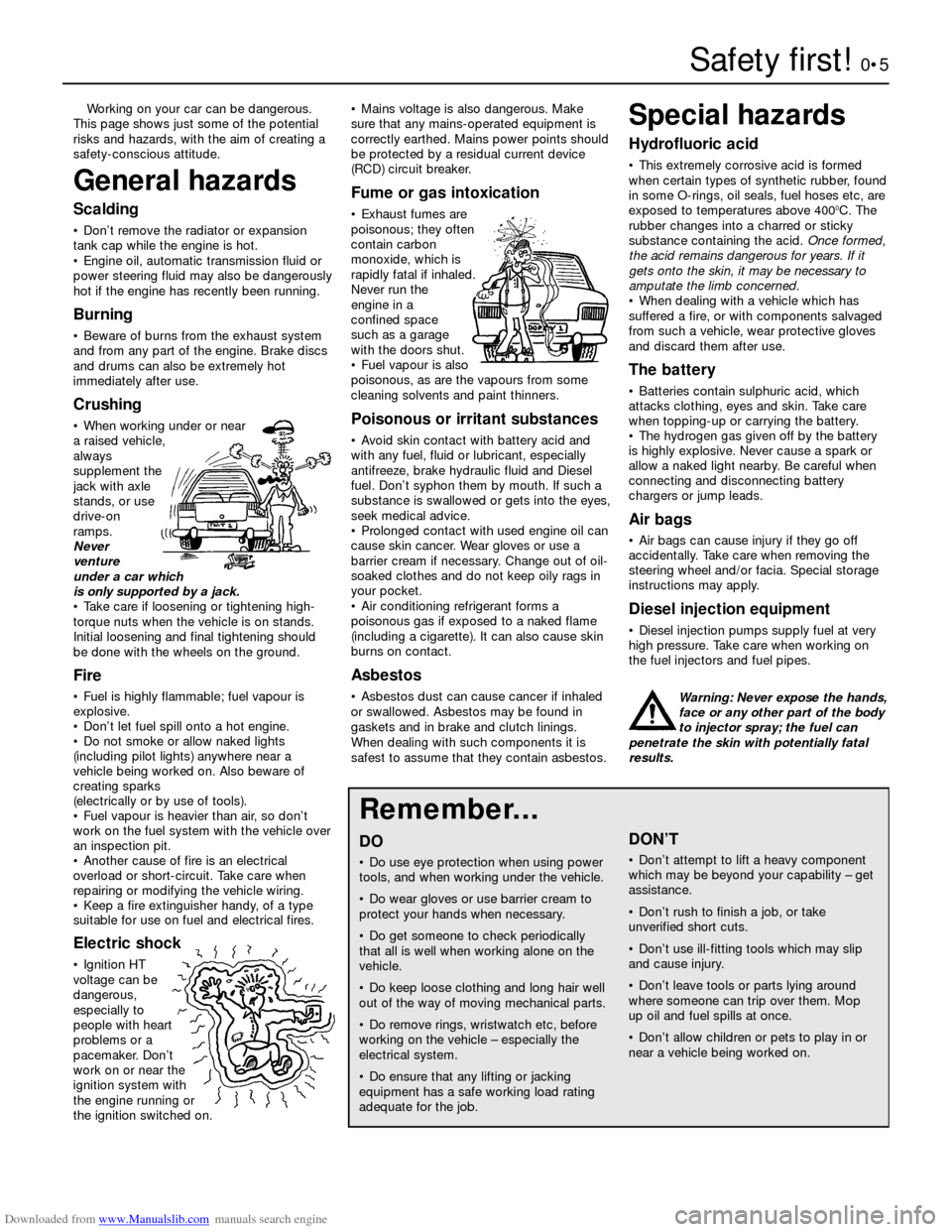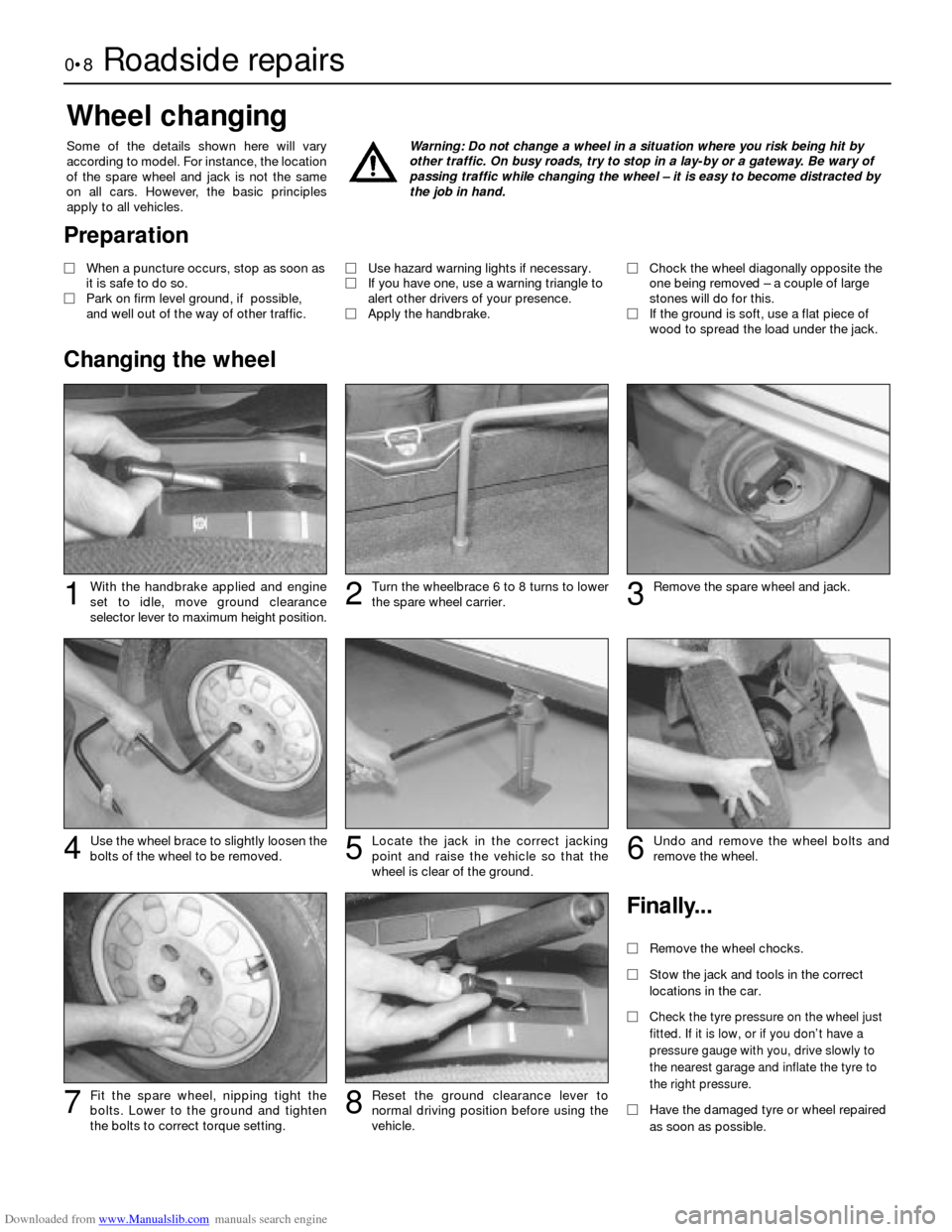jacking Citroen BX HATCHBACK 1991 2.G Workshop Manual
[x] Cancel search | Manufacturer: CITROEN, Model Year: 1991, Model line: BX HATCHBACK, Model: Citroen BX HATCHBACK 1991 2.GPages: 16, PDF Size: 0.47 MB
Page 3 of 16

Downloaded from www.Manualslib.com manuals search engine REPAIRS & OVERHAUL
Engine and Associated Systems
150 engine repair procedures Page2A•1
171 and 159 engine repair procedures Page2B•1
K1G engine repair procedures Page2C•1
D6C engine repair procedures Page2D•1
Cooling, heating and air conditioning systems Page3•1
Fuel and exhaust systems - carburettor models Page4A•1
Fuel and exhaust systems - Bosch LE3 Jetronic injection Page4B•1
Fuel and exhaust systems - Motronic injection Page4C•1
Fuel and exhaust systems - Magneti Marelli injection Page4D•1
Ignition system - carburettor models Page5A•1
Ignition system - fuel injection models Page5B•1
Starting and charging systems Page5C•1
Transmission
ClutchPage6•1
Manual gearboxPage7A•1
Automatic transmission Page7B•1
DriveshaftsPage8•1
Brakes and Suspension
Hydraulic systemPage9•1
Braking systemPage10•1
Suspension and steering Page11•1
Body Equipment
Bodywork and fittingsPage12•1
Body electrical systems Page13•1
Wiring DiagramsPage13•16
REFERENCEDimensions and weights PageREF•1
Conversion factorsPageREF•2
Buying spare partsPageREF•3
Vehicle Identification PageREF•3
General repair procedures PageREF•4
Jacking and vehicle support PageREF•5
Tools and working facilities PageREF•6
MOT test checksPageREF•8
Fault findingPageREF•12
Glossary of technical terms PageREF•19
IndexPageREF•23
Contents
Page 5 of 16

Downloaded from www.Manualslib.com manuals search engine Safety first!0•5
Working on your car can be dangerous.
This page shows just some of the potential
risks and hazards, with the aim of creating a
safety-conscious attitude.
General hazards
Scalding
• Don’t remove the radiator or expansion
tank cap while the engine is hot.
• Engine oil, automatic transmission fluid or
power steering fluid may also be dangerously
hot if the engine has recently been running.
Burning
• Beware of burns from the exhaust system
and from any part of the engine. Brake discs
and drums can also be extremely hot
immediately after use.
Crushing
• When working under or near
a raised vehicle,
always
supplement the
jack with axle
stands, or use
drive-on
ramps.
Never
venture
under a car which
is only supported by a jack.
• Take care if loosening or tightening high-
torque nuts when the vehicle is on stands.
Initial loosening and final tightening should
be done with the wheels on the ground.
Fire
• Fuel is highly flammable; fuel vapour is
explosive.
• Don’t let fuel spill onto a hot engine.
• Do not smoke or allow naked lights
(including pilot lights) anywhere near a
vehicle being worked on. Also beware of
creating sparks
(electrically or by use of tools).
• Fuel vapour is heavier than air, so don’t
work on the fuel system with the vehicle over
an inspection pit.
• Another cause of fire is an electrical
overload or short-circuit. Take care when
repairing or modifying the vehicle wiring.
• Keep a fire extinguisher handy, of a type
suitable for use on fuel and electrical fires.
Electric shock
• Ignition HT
voltage can be
dangerous,
especially to
people with heart
problems or a
pacemaker. Don’t
work on or near the
ignition system with
the engine running or
the ignition switched on.• Mains voltage is also dangerous. Make
sure that any mains-operated equipment is
correctly earthed. Mains power points should
be protected by a residual current device
(RCD) circuit breaker.
Fume or gas intoxication
• Exhaust fumes are
poisonous; they often
contain carbon
monoxide, which is
rapidly fatal if inhaled.
Never run the
engine in a
confined space
such as a garage
with the doors shut.
• Fuel vapour is also
poisonous, as are the vapours from some
cleaning solvents and paint thinners.
Poisonous or irritant substances
• Avoid skin contact with battery acid and
with any fuel, fluid or lubricant, especially
antifreeze, brake hydraulic fluid and Diesel
fuel. Don’t syphon them by mouth. If such a
substance is swallowed or gets into the eyes,
seek medical advice.
• Prolonged contact with used engine oil can
cause skin cancer. Wear gloves or use a
barrier cream if necessary. Change out of oil-
soaked clothes and do not keep oily rags in
your pocket.
• Air conditioning refrigerant forms a
poisonous gas if exposed to a naked flame
(including a cigarette). It can also cause skin
burns on contact.
Asbestos
• Asbestos dust can cause cancer if inhaled
or swallowed. Asbestos may be found in
gaskets and in brake and clutch linings.
When dealing with such components it is
safest to assume that they contain asbestos.
Special hazards
Hydrofluoric acid
• This extremely corrosive acid is formed
when certain types of synthetic rubber, found
in some O-rings, oil seals, fuel hoses etc, are
exposed to temperatures above 400
0C. The
rubber changes into a charred or sticky
substance containing the acid. Once formed,
the acid remains dangerous for years. If it
gets onto the skin, it may be necessary to
amputate the limb concerned.
• When dealing with a vehicle which has
suffered a fire, or with components salvaged
from such a vehicle, wear protective gloves
and discard them after use.
The battery
• Batteries contain sulphuric acid, which
attacks clothing, eyes and skin. Take care
when topping-up or carrying the battery.
• The hydrogen gas given off by the battery
is highly explosive. Never cause a spark or
allow a naked light nearby. Be careful when
connecting and disconnecting battery
chargers or jump leads.
Air bags
• Air bags can cause injury if they go off
accidentally. Take care when removing the
steering wheel and/or facia. Special storage
instructions may apply.
Diesel injection equipment
• Diesel injection pumps supply fuel at very
high pressure. Take care when working on
the fuel injectors and fuel pipes.
Warning: Never expose the hands,
face or any other part of the body
to injector spray; the fuel can
penetrate the skin with potentially fatal
results.
Remember...
DO
• Do use eye protection when using power
tools, and when working under the vehicle.
• Do wear gloves or use barrier cream to
protect your hands when necessary.
• Do get someone to check periodically
that all is well when working alone on the
vehicle.
• Do keep loose clothing and long hair well
out of the way of moving mechanical parts.
• Do remove rings, wristwatch etc, before
working on the vehicle – especially the
electrical system.
• Do ensure that any lifting or jacking
equipment has a safe working load rating
adequate for the job.
A few tips
DON’T
• Don’t attempt to lift a heavy component
which may be beyond your capability – get
assistance.
• Don’t rush to finish a job, or take
unverified short cuts.
• Don’t use ill-fitting tools which may slip
and cause injury.
• Don’t leave tools or parts lying around
where someone can trip over them. Mop
up oil and fuel spills at once.
• Don’t allow children or pets to play in or
near a vehicle being worked on.
Page 8 of 16

Downloaded from www.Manualslib.com manuals search engine 0•8Roadside repairs
With the handbrake applied and engine
set to idle, move ground clearance
selector lever to maximum height position.
Wheel changing
Some of the details shown here will vary
according to model. For instance, the location
of the spare wheel and jack is not the same
on all cars. However, the basic principles
apply to all vehicles.Warning: Do not change a wheel in a situation where you risk being hit by
other traffic. On busy roads, try to stop in a lay-by or a gateway. Be wary of
passing traffic while changing the wheel – it is easy to become distracted by
the job in hand.
Finally...
MRemove the wheel chocks.
MStow the jack and tools in the correct
locations in the car.
M
Check the tyre pressure on the wheel just
fitted. If it is low, or if you don’t have a
pressure gauge with you, drive slowly to
the nearest garage and inflate the tyre to
the right pressure.
MHave the damaged tyre or wheel repaired
as soon as possible.
Use the wheel brace to slightly loosen the
bolts of the wheel to be removed.Locate the jack in the correct jacking
point and raise the vehicle so that the
wheel is clear of the ground.Undo and remove the wheel bolts and
remove the wheel.
Remove the spare wheel and jack.Turn the wheelbrace 6 to 8 turns to lower
the spare wheel carrier.123
4
Fit the spare wheel, nipping tight the
bolts. Lower to the ground and tighten
the bolts to correct torque setting.7Reset the ground clearance lever to
normal driving position before using the
vehicle.8
56
Preparation
MWhen a puncture occurs, stop as soon as
it is safe to do so.
MPark on firm level ground, if possible,
and well out of the way of other traffic.MUse hazard warning lights if necessary.
MIf you have one, use a warning triangle to
alert other drivers of your presence.
MApply the handbrake.MChock the wheel diagonally opposite the
one being removed – a couple of large
stones will do for this.
MIf the ground is soft, use a flat piece of
wood to spread the load under the jack.
Changing the wheel